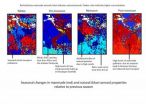(Press-News.org) By studying similarities in the genes of Scots Pine trees, scientists have shown that the iconic pine forests of Highland Scotland still carry the traces of the ancestors that colonised Britain after the end of the last Ice Age, harbouring genetic variation that could help regenerate future populations, according to new results published in the journal Heredity.
The research was carried out by an international team from the Centre for Ecology & Hydrology, the Polish Academy of Sciences, the University of Edinburgh and the Macaulay Land Use Research Institute.
Today's Scots Pine forests are remnants of the ancient, much larger Caledonian forest that covered the northern parts of Britain from the end of the last Ice Age until many trees were lost due to over-exploitation and agriculture more than 400 years ago.
It has previously been thought that as the trees were lost so was much of the genetic diversity contained within them. Without sufficient genetic diversity the remaining pine tree populations may not be able to adapt and survive under new conditions, for example as the climate changes.
By studying the remnant Scottish populations the researchers were able to see how much genetic variation remains and also how these trees compare to the intact Scots Pine forests of continental Europe and Asia.
The good news is that Scottish populations turn out to be at least as genetically diverse as their continental cousins. This suggests that despite the huge losses they have suffered, the last fragments of the Caledonian Pine forest in Scotland still harbour genetic variation that could help regenerate future populations.
"Despite its Scottish image, the Scots Pine owes much to its European roots." said paper co-author Dr Stephen Cavers, an ecologist based at the Centre for Ecology & Hydrology's Edinburgh site, "By looking at the trees' DNA we have learnt much about how the forests grew up after the Ice Age. Given the severe fragmentation of the current population, our results are key to understanding how these forests will cope with future change."
Where the genetic diversity comes from is another question. Given the great age that these trees can reach – as much as 700 years in some cases – the forests present today may be no more than a few tens of generations removed from the first migrants to reach these shores after the ice retreated. DNA evidence suggests that these early arrivals came in two waves: one, which reached the far north-western Highlands very soon after the ice retreated, possibly via Ireland, and another, which settled in the eastern Highlands, from central Europe.
Dr Cavers added, "We plan to continue the study, to try and discover if there are particular genes which let the Highland trees tolerate the harsh Scottish climate."
INFORMATION:
Scots Pine shows its continental roots
2010-09-09
ELSE PRESS RELEASES FROM THIS DATE:
Study adds new clue to how last ice age ended
2010-09-09
As the last ice age was ending, about 13,000 years ago, a final blast of cold hit Europe, and for a thousand years or more, it felt like the ice age had returned. But oddly, despite bitter cold winters in the north, Antarctica was heating up. For the two decades since ice core records revealed that Europe was cooling at the same time Antarctica was warming over this thousand-year period, scientists have looked for an explanation.
A new study in Nature brings them a step closer by establishing that New Zealand was also warming, indicating that the deep freeze up north, ...
Investigating better endpoints for immunotherapy trials
2010-09-09
Cancer immunotherapy calls for revised clinical endpoints that differ from those used for chemotherapy, according to an article published online September 8 in The Journal of the National Cancer Institute.
Unlike chemotherapy, which acts directly on tumors, cancer immunotherapies exert their effects on the immune system, which may delay or change response patterns, perhaps owing to the dynamics of the immune system itself. For example, initial tumor burden may increase due to lymphocytic infiltration, because of T-cell proliferation, which is followed by lymphocyte-induced ...
Researchers identify potential new drug for neurodegenerative disease
2010-09-09
BOSTON, Mass. (September 8, 2010)‹Scientists have discovered a small
molecule that helps human cells get rid of the misfolded, disfigured
proteins implicated in Alzheimer¹s disease and other neurodegenerative
ailments. This potential drug could have applications for other conditions
as well.
Cells create and discard proteins continuously, a process that relies on a
balance between the speed with which new proteins are created and damaged
ones destroyed. Protein destruction occurs through a sophisticated system
that marks proteins for disposal by tagging them with ...
New study suggests changes in diagnosis and treatment of malaria
2010-09-09
LA JOLLA, CA - September 7, 2010 –A team of scientists from The Scripps Research Institute, the Genomics Institute of the Novartis Research Foundation (GNF), and the U. S. Naval Research Detachment in Peru has completed a study that could improve the efficacy of diagnosis and treatment strategies for drug-resistant malaria.
In the new study—published online on September 9, 2010 by the journal Genome Research—the scientists analyzed the genomic features of a population of malaria parasites in Peru, identifying the genetic basis for resistance to a common antibiotic.
Malaria ...
NIST researchers hear puzzling new physics from graphene quartet's quantum harmonies
2010-09-09
GAITHERSBURG, Md. – Using a one-of-a-kind instrument designed and built at the National Institute of Standards and Technology (NIST), an international team of researchers have "unveiled" a quartet of graphene's electron states and discovered that electrons in graphene can split up into an unexpected and tantalizing set of energy levels when exposed to extremely low temperatures and extremely high magnetic fields. Published in this week's issue of Nature,* the new research raises several intriguing questions about the fundamental physics of this exciting material and reveals ...
New sickle cell screening program for college athletes comes with serious pitfalls, experts say
2010-09-09
The Johns Hopkins Children's Center top pediatrician is urging a "rethink" of a new sickle cell screening program, calling it an enlightened but somewhat rushed step toward improving the health of young people who carry the sickle cell mutation.
Beginning this fall, all Division I college athletes will undergo mandatory screening for the sickle cell trait. The program, rolled out by the National Collegiate Athletic Association (NCAA), is an attempt to prevent rare but often-lethal complications triggered by intense exercise in those who carry the genetic mutation yet ...
Liver defect likely cause of DHA deficiency in Alzheimer's patients, UCI study finds
2010-09-09
Irvine, Calif. — UC Irvine researchers have discovered that markedly depleted amounts of an omega-3 fatty acid in brain tissue samples from Alzheimer's patients may be due to the liver's inability to produce the complex fat, also contained in fish-oil supplements.
Low levels of docosahexaenoic acid, or DHA, have been associated with the chronic neurodegenerative disease affecting millions of Americans, but no cause had been identified.
In postmortem liver tissue from Alzheimer's patients, the UCI team found a defect in the organ's ability to make DHA from shorter molecules ...
The Economics of Ecosystems and Biodiversity (TEEB) Local and Regional Policy Makers report launched at major biodiversity conference in Ghent
2010-09-09
Ghent, 9 September 2010 – Factoring the planet's multi-trillion dollar ecosystem services into policy-making can help save cities and regional authorities money while boosting the local economy, enhancing quality of life, securing livelihoods and generating employment.
This is the finding from a major international study, launched in a report by TEEB for Local and Regional Policy Makers, being released in Belgium, Brazil, India, Japan and South Africa.
In the Framework of the Belgian Presidency of the European Union, the Flemish Ministry of Environment, Nature and ...
Unauthorized population would soar if birthright citizenship repealed
2010-09-09
University Park, Pa. -- Repeal of birthright citizenship for the U.S.-born children of unauthorized immigrants would expand the nation's unauthorized population by at least 5 million over the next decade, according to a new report from the Migration Policy Institute.
The report's principal author is Jennifer Van Hook, professor of sociology and demographics at Penn State and non-resident fellow at the Washington, D.C.-based institute.
"While some are discussing an end to birthright citizenship as a means to reduce illegal immigration," Van Hook said, "repeal of birthright ...
Satellite data reveal seasonal pollution changes over India
2010-09-09
CHAMPAIGN, Ill. — Armed with a decade's worth of satellite data, University of Illinois atmospheric scientists have documented some surprising trends in aerosol pollution concentration, distribution and composition over the Indian subcontinent.
In addition to environmental impact, aerosol pollution, or tiny particles suspended in the air, can be detrimental to human health by causing a range of respiratory problems. Aerosols can come from natural sources, such as dust and pollen carried on the wind, but the most hazardous aerosols are generated by human activity – soot ...



